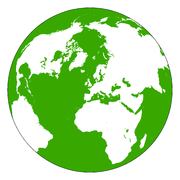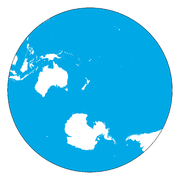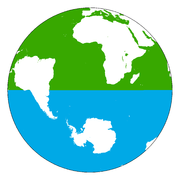Land and water hemispheres




The Land and Water Hemispheres of Earth, sometimes capitalised as the Land Hemisphere and Water Hemisphere, are the hemispheres on Earth containing the largest possible total areas of land and ocean respectively. By definition (assuming that the entire surface can be classed as either "land" or "water") the two hemispheres do not overlap.
Determinations of the hemispheres vary slightly. One determination places the centre of the Land Hemisphere at 47°13′N 1°32′W / 47.217°N 1.533°W (in the city of Nantes, France).[1] The center of the water hemisphere is the antipodal point of the center of the land hemisphere, and is therefore located at 47°13′S 178°28′E / 47.217°S 178.467°E, near New Zealand's Bounty Islands in the Pacific Ocean.[1]
An alternative assignment determines the centre of the Land Hemisphere to be at 47°24′42″N 2°37′15″W / 47.411667°N 2.620833°W (in île Dumet near Saint-Nazaire, France)[2][3]
The Land Hemisphere has just under seven-eighths of the land on Earth, including Europe, Africa, North America, nearly all of Asia and most of South America. However, even in the Land Hemisphere, the ocean area still slightly exceeds the land area.
The Water Hemisphere has only about one-eighth of the world's land,[1] including Australia, New Zealand, Antarctica, Hawaii, the Maritime Southeast Asia, and the Southern Cone. Most of the Pacific Ocean and the Indian Ocean are on the water hemisphere. Proportionately, the Water Hemisphere is approximately 89% water, 6% dry land and 5% polar icecap.[1]
See also
References
- 1 2 3 4 Boggs, Samuel Whittemore (December 1945). "This Hemisphere". Journal of Geography. 44 (9): 345–355. doi:10.1080/00221344508986498.
- ↑ Berget, Alphonse (1913). "Répartition géographique des Océans (détermination du pôle continental)". 10 (in French). V. Annales de l'Institut océanographique.
- ↑ "L'ILE DUMET: LE NOMBRIL DU MONDE". France Secret (in French). Archived from the original on 24 April 2016.